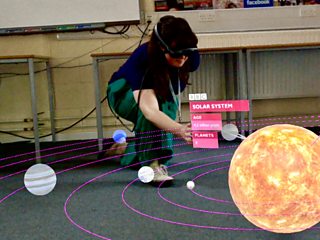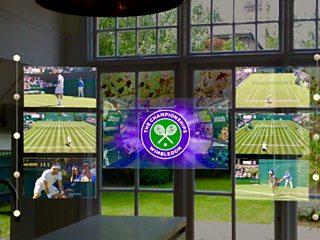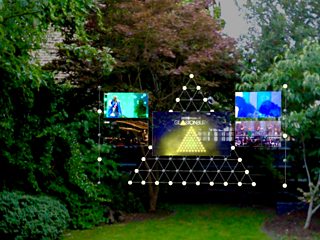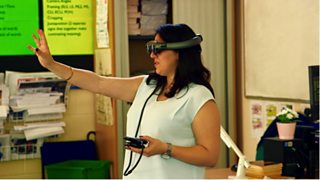Could smartglasses and holograms transform TV, news and education?
Cyrus Saihan
Digital Partnerships
Tagged with:
As global technology companies start to invest in smartglasses technology as a possible replacement for smartphones, the Βι¶ΉΤΌΕΔ has experimented with how audiences might watch TV, access the news and learn about new topics using new augmented reality technology, holograms and smartglasses. Cyrus Saihan is Head of Digital Partnerships, Distribution & Business Development and explains more on this exciting project.
Whether it is in films such as The Avengers, The Terminator or Kingsman, augmented reality headsets – devices that overlay holographic digital images onto the real-world – have been portrayed in science fiction as a type of cutting edge technology for many years. However, with recent advances and heavy investment in smartglasses from well-funded companies, there is now a chance that these types of heads-up digital display experiences could go mainstream.
New augmented reality smartglasses could end up being a replacement for our smartphones and becoming an integral part of our daily lives. The immersive nature of augmented reality, effectively projecting holograms into your eyes and enabling you to physically interact with those holograms, could offer exciting new ways to watch TV, access the news and learn about subjects in a far more effective way than has ever been possible before. We therefore wanted to see how smartglasses, holograms and augmented reality technology could be used now and in the future for TV and news. The Βι¶ΉΤΌΕΔ also has a long history of producing content for learning, so we wanted to experiment to see how these types of holograms and devices might help pupils and teachers in the classrooms of the future.
Our augmented reality smartglasses experiment
For our experiment, we worked with the UK digital agency and some of our R&D team. We created holographic examples for learning content, such as animations of the solar system, a strand of DNA and a brain neuron; we also experimented with a version of Βι¶ΉΤΌΕΔ News that floats in mid-air and a holographic big TV screen experience that lets you choose what to watch from a range of different performers at Glastonbury, or select which tennis match you want to watch at Wimbledon.

Our moving solar system hologram


Our augmented reality Βι¶ΉΤΌΕΔ News experience
What is augmented reality and what are smartglasses?
Augmented reality is a technology that enables your digital world and your real-world to merge. Digital objects can appear as if they physically exist. So a digital video, news article or object can appear as if it is floating right in front of you, like a hologram. You can even interact with these digital floating objects like you do with objects in the real-world. For example, you can press a “virtual” digital button in thin air in the same way that you might press a button on a touch screen or TV remote control.

A multi-screen holographic TV experience that lets you watch sporting events such as Wimbledon

A virtual music festival at home – imagine choosing which stage to watch at Glastonbury whilst sitting in your garden

A pupil and teacher interacting with a holographic neuron in the classroom
The latest augmented reality technologies, such as the device that we used, are also capable of 3D scanning and mapping the real-world around you. Once a space, such as a living room, has been scanned and mapped, the technology is able to understand in detail the layout of the immediate environment (for example, how big the room is, where the walls are, what furniture is in the room and where the furniture is positioned).
The technology can then apply the rules of physics to enable that digital object to interact with your real-world environment. So you can bounce a virtual digital ball off the real coffee table in your living room, or as in our experience, hang several huge virtual TV screens on your living room wall or have them floating in mid-air in your garden.
Augmented reality has existed on phones and tablets for some time now, but the introduction of augmented reality smartglasses introduces a completely new form factor to the market that lends itself to a different and potentially far more natural interaction with virtual digital objects. Instead of staring head down at your phone, with a pair of smartglasses, you might be able to walk around and see the digital objects float like holograms right in front of you as move around.
Did it work?
Quite simply, yes. When you put on the smartglasses and walked around, the digital objects felt so realistic that you wanted to reach out and touch them, believing that they are actually in the room with you. What made the experience even more realistic is that, as in the real-world, the closer that you get to a digital object, the more detail you could see on it. We are generally used to digital objects pixilating as you zoom in or get closer to them, so seeing this extra detail as you got closer to the object adds to the realism.
Smartglasses are not widely available at the moment and our experiment was just an internal prototype, but we tested out our experiences with a few pupils, teachers and colleagues to see what they thought. Reactions to the experience were generally very positive, with people saying that it was “really beautiful…I’m quite awe-inspired” and that they felt that “it could really help different types of learners”.
What does the future hold for smartglasses?
Whilst our experiment with augmented reality and smartglasses worked very well, it was far from perfect.
The glasses are still quite bulky (closer in size to a pair of ski goggles than to a standard pair of glasses) and the complicated computing power means that, for the device that we experimented with, you have to carry with you a small palm sized computer. Another key limitation of the current smart glasses technology is the limited field of view – the device that we used gave you a field of view of the digital objects of around 40 degrees (which is considerably less than an average human field of view), meaning that if you looked too far to the left or right, you started to lose some of the ability to view the holograms, which in turn made the experience less realistic and less practically useful.

However, it is very early days for smartglasses and it is likely that the technology will improve and progress – if you were to compare the mobile phones of the late 1990s to the smartphones of today, the jump in terms of their capabilities is huge, and that is very likely to be the case with the smartglasses of today compared to those that we will see in the coming years.
The smartglasses that we experimented with let us see into a possible future, one in which we might be watching TV, accessing the news and learning about new subjects in a far more immersive way than has ever been possible before. If smartglasses do take off, our digital world and our real-world could combine in a way that has never been possible before, potentially transforming the future of media.
